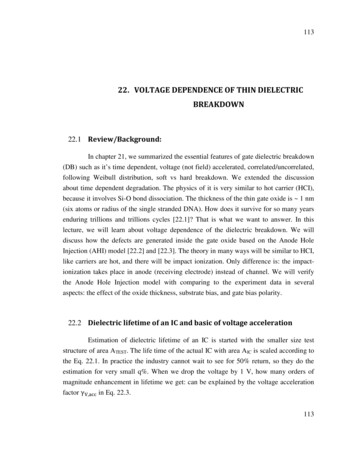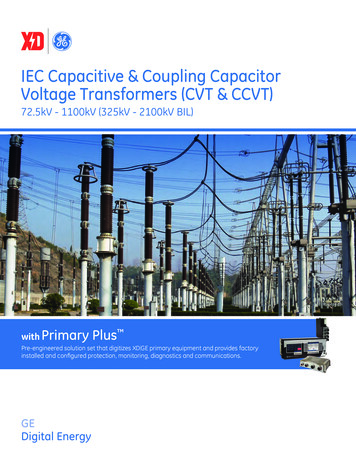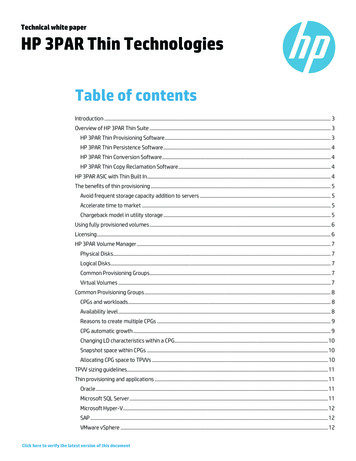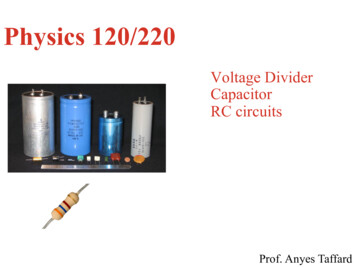
Transcription
11322. VOLTAGE DEPENDENCE OF THIN DIELECTRICBREAKDOWN22.1 Review/Background:In chapter 21, we summarized the essential features of gate dielectric breakdown(DB) such as it’s time dependent, voltage (not field) accelerated, correlated/uncorrelated,following Weibull distribution, soft vs hard breakdown. We extended the discussionabout time dependent degradation. The physics of it is very similar to hot carrier (HCI),because it involves Si-O bond dissociation. The thickness of the thin gate oxide is 1 nm(six atoms or radius of the single stranded DNA). How does it survive for so many yearsenduring trillions and trillions cycles [22.1]? That is what we want to answer. In thislecture, we will learn about voltage dependence of the dielectric breakdown. We willdiscuss how the defects are generated inside the gate oxide based on the Anode HoleInjection (AHI) model [22.2] and [22.3]. The theory in many ways will be similar to HCI,like carriers are hot, and there will be impact ionization. Only difference is: the impactionization takes place in anode (receiving electrode) instead of channel. We will verifythe Anode Hole Injection model with comparing to the experiment data in severalaspects: the effect of the oxide thickness, substrate bias, and gate bias polarity.22.2 Dielectric lifetime of an IC and basic of voltage accelerationEstimation of dielectric lifetime of an IC is started with the smaller size teststructure of area ATEST. The life time of the actual IC with area AIC is scaled according tothe Eq. 22.1. In practice the industry cannot wait to see for 50% return, so they do theestimation for very small q%. When we drop the voltage by 1 V, how many orders ofmagnitude enhancement in lifetime we get: can be explained by the voltage accelerationfactor γ , in Eq. 22.3.113
114%1% %&'( )(%) 1* / 100#0.510 -./%%22.1%#301,&2222.222.3In Fig. 22.1 (left) for very large gate bias empirical projection matches well with theactual curve. However, once the operating bias converges to the safe operating voltagewe see that empirical observation is showing pessimistic behavior. In principle we canuse a slightly higher voltage to make faster computer, if we know the essential physics.The right side plot shows the voltage acceleration factor which is the slope of the leftplot. Voltage acceleration factor is related with the IC lifetime through the Eq. 22.3.Figure 22.1 Mean life time vs gate bias plot shows that lifetime increases with thereduction of gate bias. Physics is important to understand the deviation of the actualcurve (blue) from the projection (red). (Right) The slope of the mean life time vs VGcurve known as voltage acceleration factor (γ) is plotted with respect to the gate bias. Theexperimental data for oxides of different thickness from the literature (symbols) comparequite well with the simulation results (solid line).114
11522.3 Anode hole injection (AHI) modelThe anode hole injection model describes a physical process to explain thedefect generation inside the gate dielectric material [22.4]. According to this model,carriers injected from the gate (substrate) undergo negligible energy loss as they travelthrough the oxide and on reaching the substrate (gate) these high-energy (“hot”) electronscause impact ionization producing hot holes (See Fig. 22.2). The hot holes tunneling backinto the oxide increase the current density at localized spots, probably through holeinduced trap generation, until the final runaway process leads to the catastrophicbreakdown. The term Anode Hole Injection (AHI) arises from old cathode tubeterminology. Cathode emits the particles and anode collects them. In this case gate(substrate) emits electrons and substrate (gate) collects them and the degradation (defectgeneration in the oxide) is due to the holes created at the anode.If electron current J5 , impact ionization coefficient γ66 , and hole transmissioncoefficient T8 are controlled by electric field (9), they can be represented as:(; 922.40?@ ; @ 922.5AB ; B 922.6CD:( 0?A22.7C FD G22.8 22.9C 1/9115
116Fig. 22.2 (top) Anode-Hole Injection model. (Bottom left) high VGS: impactionization inside thick oxide is controlled by electric field. (Bottom middle)medium VGS: electrons are so energetic, they creates Plasmon inside the gate.(Bottom right) low VGS with thin oxide: electrons lose little energy to anodegenerating carriers through impact ionization. We will discuss this model toexplain thin dielectric breakdown.116
117Fig. 22.3 Three pieces of information: electron current (red line), hole current(blue line), and impact ionization phenomena in poly gate are explained throughband diagram.From electron current, impact ionization coefficient, and hole transmissioncoefficient dielectric breakdown time in general can be calculated by exploiting equation22.9.In the framework of AHI model, the amount of defects created depends on thehot hole flux and is given by:I:( 0?A22.10where :I denotes the hole flux from the anode, :( denotes the electron flux to theanode, 0? denotes the impact ionization factor ( 1-3) and J denotes the holetransmission probability through the gate oxide. To compute the tunneling currents andimpact ionization rates, an AHI model that heavily utilizes numerical methods wasproposed. Electron tunneling current is obtained by solving the Poisson and Schrodingerequations self-consistently to account for quantum mechanical effects. Impact ionizationrates are computed by full-band Monte-Carlo Simulations, as shown in Fig. 22.4. At lowenergy there are only very few carriers to cause impact ionization in Fig. 22.4 (middle).There is a notch in the red curve (Fig. 22.4 (right)) because a separate valley essentiallycomes in.117
11822.4 Constant field vs bulk impact ionizationConstant field impact ionization takes place near the drain side in the channel orin the thick oxide depending on biasing arrangement. Impact ionization generation rate isa function of electric field, so constant field impact ionization. Constant field impactionization coefficient can be represented by the expression 22.5. In the case of thin oxideimpact ionization is dependent on gate bias instead of electric field through Eq. 22.11.However, if the applied bias (thin oxide) is very high, instead of generating carriersexponentially, the generation rate will be limited by the expression 22.12. Before secondimpact ionization carriers need a time to relax, which reduces the energy of the carrierdrastically.0? ; K L0?13M9 9O,)I P22.11M9 9O,)I P22.1222.5 AHI model at high and low voltages (thin oxide)If VG is relatively high, electron tunneling current and impact ionizationcoefficient are represented by Eqs. 22.5 and 22.12, respectively. Hole tunnelingcoefficient will be independent of electric field. So, dielectric lifetime can be explainedby the by Eq. 22.9. However, if VG is relatively low, electron tunneling current will notbe exponential function of electric field, the dielectric lifetime is controlled by the gatebias (Eqs. 22.13, 22.14, and 22.15).:(〈0? A〉CF 922.13U; K L M:( 0?AP22.1401 L22.15118
119What will be the dielectric lifetime in between (high and low VG)? The lifetimecan be represented by the following expression. Detail derivation procedure is added inthe appendix of the lecture.:A,%VWBMY(O 9O,)I P:( 0? X 2[\I / ; ΦaBMY(O/ βEde9O,)I Pf22.16Here, W5h is the energy of the ballistic electron causing impact ionization, qΦa is thebarrier height for hole (for Si/SiO2 interface it is 4.9 eV), m k is the effective mass of hole/ inside gate oxide, Ede is the oxide electric field, βEde is the Schottky barrier lowering.The expression of the above equation is a counterpart to that of hot electron.Fig. 22.4 Numerical calculation of the hole current components: (left) electroninjection current (red symbols are measurement), (middle) impact ionizationfactor, and (right) hole tunneling probability.119
120The dielectric life time is the flipped of the Jh/Je vs VG curve. With the increaseof gate bias hole density with higher transmission probability increases exponentially.The measured experimental results are shown in Fig. 22.5 (top left) only at high gatebias. Electron concentration at the interface is showing a ballistic peak and holeconcentration is gradually going down at higher energies (Fig. 22.5 (bottom left)). To getthe transmitted flux through the oxide we have to multiply the hole concentration at theinterface with energy dependent transmission coefficient (Fig. 22.5 (bottom right)).120
121Fig. 22.5 (Top left) Jh/Je vs VG plot. (Top right) With the increase of the gate biashole density with higher transmission probability increases exponentially. (Bottomleft) Electron and hole flux vs energy. Electron flux is showing a ballistic peak(indicated by arrow). Hole concentration is gradually going down at higherenergies. (Bottom right) Transmitted hole flux, i.e., generated hole multiplied bythe transmission coefficient vs energy is plotted. Transmission probability ofhole is higher at higher energies.121
12222.6 Validation of AHI model with experimentThe verification of AHI model is very important because an improperexamination of theory might cause an astronomical loss to the industry. Thus we needto verify the theory with experimental data in lots of aspects. According to the anodehole injection model, the determination of oxide time-to-breakdown (TBD) depends onmultiple factors such as the oxide thickness and polarity of the oxide barrier. In thissection some of these factors that affect TBD are discussed.22.7 Thickness dependenceOne puzzling feature of voltage scaling of TDDB is that for the same oxidefield, thinner oxides have relatively higher projected reliability (higher field accelerationfactor) compared to the thicker oxide (See Error! Reference source not found. (right)) [22.5]. This suggest us to use parameter other than electric field, could possibly bevoltage, to explain the dielectric lifetime as a function of gate oxide thickness. Thiscounter-intuitive result can be explained within the framework of AHI model whichrequires the lifetime data be plotted as a function of voltage rather than electric field. Ifthe electric field is fixed across the oxide layers, then the voltage drop across the oxidehas to be lower for the thinner oxide [22.6]. Thus the tunneling electrons do not have somuch energy so they can produce fewer holes. Since the lifetime is inversely proportionalto the hole tunneling current, thinner oxides show better voltage acceleration.122
123Fig. 22.6 For the same electric field (Top left) Schematic band diagram for thinoxide with low applied bias and (middle) for thick oxide with high bias.(Right) Dielectric breakdown cannot be explained universally (not scalable)using field dependent model. Field dependent plot is showing higherdielectric lifetime for thinner oxide at same lower electric field, which isanomalous.22.8 Effect of back-gate biasThe application of back-gate bias can influence the oxide time-to-breakdown.Fig. 22.7 (left top) and (left bottom) below show a PMOS band diagram with twodifferent conditions: with and without the back-gate bias. As it can be seen from thefigure the larger positive back-gate bias, the more is the acceleration of the injectedelectrons and as a result they generate “hotter” holes. This results in higher ionization(γ66 ) of carriers in anode and a higher tunneling probability (Tp), and thus the oxidelifetime is reduced as shown in Fig. 22.7 (right).123
124Fig. 22.7 The PMOS band diagram for (Left top) no back-gate bias and (leftbottom) positive back-gate bias. (Right) simulated charge-to-breakdown vs VGSresults and corresponding experimental data for different back-gate biases.22.9 TBD difference between NMOS and PMOSThe time-to-breakdown also depends on the substrate doping type. Beforecomparing TBD of NMOS and PMOS, first let us see the three different types of impactionization in the anode. As shown in Fig. 22.8 (bottom), the n-type substrate has majoritycarrier impact ionization causing a hole of Energy Einj – EG where Einj is the energy ofinjected electrons. For p-type substrate, in addition to the majority carrier ionization(same as n-type substrate), there is an additional impact ionization called minority carrierimpact ionization. There are two types of minority carrier impact ionization: The hotelectrons can either drop to the conduction band and create a hot hole of energy Einj, or tothe valence band creating a hot hole of energy Einj EG. The holes left behind deep124
125within the valence-band, although few in number, have large kinetic energy and enhancedtunneling probabilities (See Fig. 22.9). As such, they contribute significantly to the holetunneling current.As explained in Fig. 22.8 (top left), with thin gate oxide and n-type polygate there will be majority carrier impact ionization creating low energy holes in anode(gate). Hole current through gate-oxide will be smaller, so the breakdown. Wherever, forPMOS with p-type gate with thin gate oxide (Fig. 22.8 (top right)) there will be minoritycarrier impact ionization creating highly energetic hole which will see negligible barrierwhile flowing through oxide.Here the availability of minority carrier impact ionization makes thedifference in the oxide time-to-breakdown between NMOS and PMOS (Fig. 22.8). If theenergy of the injected electron from the cathode is Einj, then the maximum energy of the“hot” hole generated in the anode due to the majority ionization is going to be Einj - EG,where EG is the silicon band gap ( 1.1 eV). This is true for the case of high gate voltagebut the ionization process changes when the applied gate voltage is low.In case of high gate voltage, the incident energy of the electrons, Einj, is muchlarger than the band gap and hence, the hole generation is primarily due to the majoritycarriers ionization. Therefore, both PMOS and NMOS have comparable impactionization coefficients (αp αn) and hole tunneling probabilities (Tp,p Tp,n) but theinjected electron current is higher in case of NMOS (Je,n Je,p). Overall, therefore,NMOS has shorter lifetime than PMOS.125
126Fig. 22.8 Schematic band diagram to explain dielectric breakdown mechanismin (Top left) NMOS and (top right) PMOS. (Bottom) types of impact ionizationincluding majority and minority carriers.126
127For the low voltage case, if the minority carriers are available then the minoritycarrier ionization can contribute significantly to the total hole tunneling current. In thecase of PMOS, due to presence of minority carriers at the anode/oxide interface,additional hole are generated due to two minority carrier ionization mechanismsdiscussed in the previous lecture. NMOS does not have free minority carriers. As a result,PMOS has higher impact ionization and hole tunneling probability (αp αn, Tp,p Tp,n)than the NMOS. Though the injected electron current is lower in case of PMOS (Je,n Je,p), the combined effect of higher hole ionization and tunneling probabilities ensuresthat the oxide breakdown time is shorter in case of PMOS.Fig. 22.9 Hole generation probabilities with minority carrier impact ionization.The probabilities for minority carrier impact ionization (sharp peaks at theright corner) are very small but the corresponding holes are very hot.22.10 Polarity of gate bias dependenceFig. 22.10 shows how the AHI model reproduces the polarity gap between gateand substrate injection. In case of negative gate bias electron current flow direction willbe opposite to the positive gate bias. Since the substrate is p-type for NMOS, there will127
128be minority carrier impact ionization with negative gate bias which was unlikely forpositive bias case. As we learnt before that minority carrier impact ionization createshighly energetic holes with higher transmission probability therefore more destructive.Dielectric lifetime goes down significantly with negative gate bias for NMOS.Fig. 22.10 Positive and negative gate bias dependence of the dielectric lifetime.Band diagram (top left) at positive gate bias, (bottom left) at negative gate bias,and (right) lifetime vs oxide electric field at positive and negative gate biases.Because of minority carrier impact ionization life time goes down at negative gatebias.22.11 Voltage scaling and universal shape of TBDThe AHI model requires that TBD be plotted as a function of gate voltage, not asa function of oxide field. For very high fields, where impact ionization is a weak functionof the electron injection energy, the two procedures are equivalent, because the hole128
129current is primarily determined by electron and hole tunneling components which can beplotted against voltage or oxide field equally well. However, at lower voltages for thinneroxides, the injection energy for electrons becomes critically important in determining theimpact ionization efficiency of the injected electrons. Since the injection energy isdirectly related to the voltage, plotting TBD against voltage becomes appropriate forthinner oxides. Therefore, we plot the simulation results for 4 and 7 nm oxides, discussedin Error! Reference source not found., as a function of voltage in Fig. 22.11.Interestingly, when scaled vertically with respect to each other (see Fig. 22.11), the TBDvs. V curve does show a “universal” shape since the two contributing processes - thetunneling current and the impact ionization, have specific voltage dependent variations.This scaling of the “y-axis” by a constant factor accounts for the difference in critical trapdensities for different oxide thicknesses (i.e., TBD NBD/R, R is the trap generation rate),so that the shape of the shifted profile reflects the voltage dependence of trap generationprocess. The field acceleration factor (γ66 ) of this particular “universal” curve as afunction of V (see Error! Reference source not found. (right)) does indicate thepossibility of improved voltage acceleration factor as gate voltage is reduced.Fig. 22.11 (Top left) The simulation results shown in Error! Reference source notfound. (right) are re-plotted as a function of gate voltage. (Bottom left) If twocurves are scaled (“y-axis” only) with respect to each other, they show a“universal” curve as a function of gate voltage. (Right) Few more results are129
13022.12 Conclusion:The Anode-Hole Injection (AHI) model provides the theoretical framework forunderstanding the time-dependent dielectric breakdown (TDDB) phenomena. The role ofhot holes in creating defects inside the gate dielectric implies that dielectric breakdown isa voltage-driven process rather than a field-driven process because the low voltage holegeneration process is dominated by the efficiency of impact ionization process which is astrong function of gate voltage. The universality of time-to-breakdown with respect togate voltage also validates that it is a voltage-driven process. AHI model also shows thatPMOS and NMOS have different voltage scaling relationship due to the availability ofminority carrier in the anode.22.13 References[22.1] M. A. Alam, Bonnie E. Weir, and P. Silverman, “A Future of Function orFailure?,” IEEE Circuits and Devices - The Electronics and Photonics Magazine18(2), pp. 42-48, 2002.[22.2] B. Weir, C. Leung, P. Silverman, and M. Alam, “Gate Dielectric Breakdown in theTime-Scale of ESD Breakdown,” Microelectronics Reliability, 45, pp. 427-436,2005.[22.3] B. E. Weir, C.-C. Leung, P. J. Silverman, and M. Alam, “Gate dielectricbreakdown: a focus on ESD protection,” Proc. of IRPS, pp. 399-404, 2004.[22.4] A. Ghetti, M. A. Alam, and J. Bude, “Anode Hole Generation Mechanisms,”Microelectronics Reliability, 41(9), pp. 1347-1354, 2001.[22.5] M. A. Alam, Jeff Bude, and A. Ghetti, “Can an Accurate Anode Hole InjectionModel Resolve the E vs. 1/E controversy?,” Proceedings of InternationalReliability Physics Symposium, pp. 21-26, (2000).[22.6] M. A. Alam, R. K. Smith, B. E. Weir, and P. J. Silverman, “UncorrelatedBreakdown of Silicon Integrated Circuits,” Nature, 6914, p. 378, 2002.130
131[22.7] M. Alam and R. K. Smith, “A Phenomenological Theory of Correlated MultipleSoft Breakdown Events in Ultrathin Gate Dielectrics, ” Proc. of InternationalReliability Physics Symposium, pp. 406-411, 2003.[22.8] M. A. Alam, B. E. Weir, and P. J. Silverman, “A study of soft and hardbreakdown-Part I: Analysis of statistical percolation conductance,” IEEETransaction on Electron Devices, 49 (2), pp. 232-238, 2002.[22.9] M. A. Alam, B. E. Weir, and P. J. Silverman, “A study of soft and hardbreakdown-Part II: Principles of area, thickness, and voltage scaling,” IEEETransaction on Electron Devices, 49 (2), pp. 239-246, 2002.[22.10] B. E. Weir, M. A. Alam, J. D. Bude, P. J. Silverman, A. Ghetti, F. Baumann, P.Diodato et al. "Gate oxide reliability projection to the sub-2 nm regime."Semiconductor Science and Technology 15 (5), p. 455, 2000.[22.11] Ben Kaczer, Robin Degraeve, Nadège Pangon, Tanya Nigam, and GuidoGroeseneken. "Investigation of temperature acceleration of thin oxide time-tobreakdown." Microelectronic engineering 48 (1), pp. 47-50, 1999.[22.12] J. S. Suehle , E. M. Vogel , B. Wang and J. B. Bernstein "TemperatureDependence of Soft Breakdown and Wear-Out in Sub-3 nm SiO2 Films", Proc.IRPS, pp.33 -39, 2000.[22.13] M. A. Alam, “SILC as a Measure of Trap Generation and Predictor of TBD inUltrathin Oxides,” IEEE Transaction on Electron Devices, 49 (2), pp. 226-231,2002.[22.14] M. Alam, D. Monroe, B. Weir, and P. Silverman, “Theory of Current-RatioMethod for Oxide Reliability: Proposal and Validation of a New Class of TwoDimensional Breakdown-Spot Characterization Techniques,” Proceedings ofInternational Electron Device Meeting, 2005.131
22.2 Dielectric lifetime of an IC and basic of voltage acceleration Estimation of dielectric lifetime of an IC is started with the smaller size test structure of area A TEST. The life time of the actual IC with area A IC is scaled according to the Eq. 22.1. In practice the industry cannot wait to see for 50% return, so they do the











